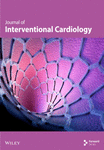The Effects of Coronary Angioplasty on Nitroglycerin-Induced Augmentation of Regional Myocardial Blood Flow
Presented in part at the 59th Scientific Session, American Heart Association, November, 1986, Dallas, Texas.
Abstract
Percutaneous transluminal coronary angioplasty (PTCA) may improve coronary vasomotor responses after relief of flow limiting luminal narrowings. To evaluate the effects of PTCA on nitro-glycerin-induced augmentation of coronary blood flow, great cardiac vein (thermodilution) blood flow and systemic hemodynamic responses to low (50 meg) and high (200 meg) dose intracoronary nitroglycerin (NTG) before and after PTCA were measured in 20 patients undergoing left anterior descending artery (LAD) balloon dilatation. Before PTCA, low dose NTG increased great vein flow 44 ±31% (from 56 ± 21 to 81 ± 33 mL/min, P < 0.01). High dose NTG increased great vein flow 55 + 30% (56 ± 23 to 87 ± 38 mL/min, P < 0.01). PTCA reduced LAD stenosis (79 ± 13 to 20 ± 9%, P < 0.01) and translesional pressure gradient (49 ± 10 to 15 ± 13 mmHg, P < 0.01) increasing post-PTCA basal great vein flow 45% (56 ± 21 mL/min to 81 ±27 mL/min, P < 0.01).
After PTCA, low dose NTG increased great vein flow only 26 ± 23% (81 ± 27 to 101 ± 39mL/min, P < 0.01; P < 0.05 versus 44 ± 31% before PTCA). The high dose NTG-induced coronary hy-peremic responses were unchanged after PTCA (55 ± 30, 55 ± 34%, P = ns). When compared to dose related NTG hyperemic responses in 10 patients with normal LAD, the post-PTCA responses remained attenuated.
These data indicate that NTG-induced augmentation of coronary blood flow remains unchanged or attenuated and does not appear to be improved by PTCA. These findings should be considered when evaluating pharmacological coronary blood flow responses after PTCA. These data also suggest that epicardial coronary resistance plays a limited role in NTG-induced augmentation of coronary blood flow inpatients with atherosclerotic coronary disease. (J Interven Cardiol 1988:1:2)




